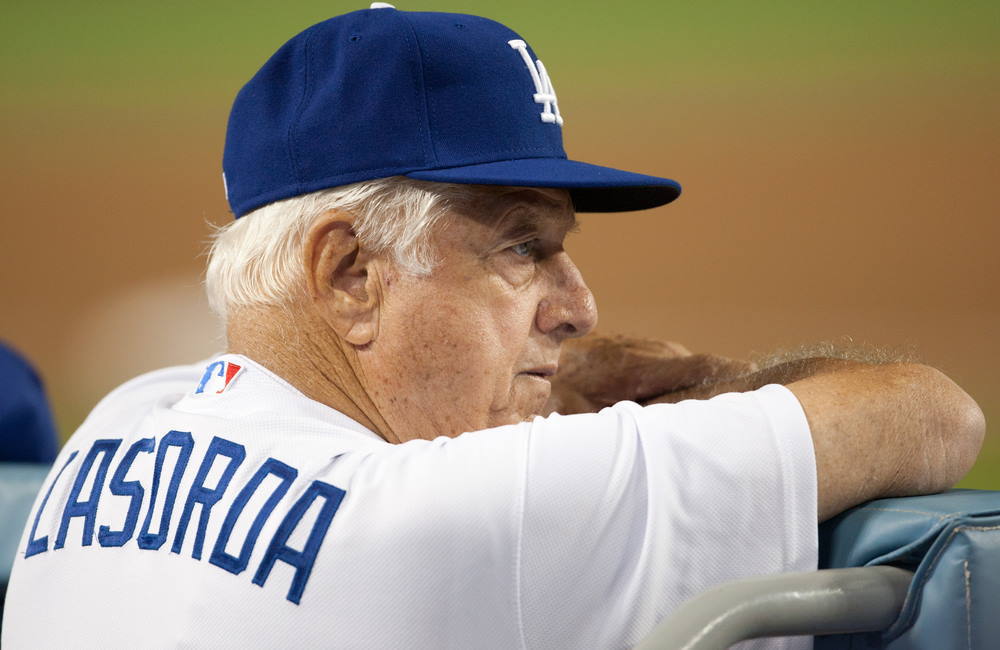Tommy Lasorda will forever be associated with the team he loved, the Los Angeles Dodgers. Lasorda managed the Dodgers for all or part of 21 seasons, winning two World Championships and four National League pennants.
“Cut my veins, and I bleed Dodger blue,” Lasorda once famously said. As a player, he debuted as a pitcher for the Brooklyn Dodgers in 1954, but only made one start for the club before the Dodgers sold his contract to the Kansas City Athletics. He appeared in 18 games for the A’s. They were his last in the Major Leagues.
While he didn’t make a mark as a player, Lasorda more than made up for it as a manager. He had a .526 winning percentage as a manager and a .508 winning percentage in 61 post-season games. His Dodgers clubs provided some of the best moments of baseball in the 1980s.
“For more than eight decades, he was the face of the Los Angeles Dodgers,” his Hall of Fame page states. “Tommy Lasorda will always remain the embodiment of Dodger Blue.”
Tommy Lasorda’s Early Life
Lasorda was born Sept. 22, 1927 in Norristown, Penn., the son of Italian immigrants. His father worked in a meatpacking plant and as a truck driver. Lasorda had four brothers. All of them went into the restaurant business.
Tommy Lasorda had other ideas. He loved playing baseball and excelled as a left-handed pitcher. The Philadelphia Phillies signed him after he graduated high school in Norristown in 1945. After pitching briefly in the minors, he joined the Army, where he stayed until 1947.
After his return, he joined the Schenectady Blue Jays of the Canadian-American League in 1948. He set a league record by striking out 25 batters in a 15-inning game on May 31, 1948, a game in which he also drove in the winning run.
The Dodgers acquired him in 1949. He spent the majority of his time with the organization – 1950 to 1954 – pitching for the Montreal Royals of the International League. He debuted with the Dodgers on Aug. 5, 1954, against the St. Louis Cardinals. He appeared in four games over the remainder of the season, giving up 5 runs in nine innings.
The Athletics purchased his contract in March 1956. He appeared in 18 games, starting five, compiling an 0-4 record and a 6.15 ERA on a terrible A’s team that finished the 1956 season 52-102. In July, the A’s traded him to the New York Yankees for Wally Burnette, a knuckleballer who played three seasons for Kansas City before injuring his shoulder and leaving baseball.
Lasorda, meanwhile, never made the big club in New York and never pitched in the majors again. But he spent time with the minor league Denver Bears, which had a tremendous impact on his life.
Lasorda’s Early Managerial Career
Lasorda later said that during his time in Denver, he learned a lot about managing players from the Bears manager. Ralph Houk, who went on to manage Yankees teams that won championships in 1961 and 1962. The most important lesson Houk imparted to the young Lasorda was to treat players like human beings, not commodities.
Best Moments of Yankees Baseball
It’s an approach Lasorda maintained his whole career. “Lasorda hugged his ballplayers, remembered their birthdays and the names of their wives and children, and exhorted them to achieve greater deeds – at times speaking in Spanish, most famously in the 1980s with Fernando Valenzuela, his ace Mexican left-hander,” the New York Times wrote about Lasorda.
After leaving baseball as a player for good in 1960, Lasorda joined the Dodgers as a scout. In 1966, he started his managerial career with the rookie league Pocatello Chiefs. He rose through the ranks of the minors as a manager, eventually becoming the Dodgers third base coach in 1973, a position he held four years.
He became manager of the Dodgers for the last four games of the 1976 season after Walter Alston retired. Alston had managed the Dodgers for 23 years in Brooklyn and Los Angeles.
Highlights of Lasorda’s Career
In addition to the pennants and championships, Lasorda also became the fourth longest serving manager in baseball history, behind only Alston, Connie Mack (who owned and managed the Athletics for 50 years) and John McGraw, who managed the New York GIants for all or part of 31 seasons. Atlanta Braves manager Bobby Cox later tied Lasorda’s 21-year run, managing the Braves from 1990 to 2010.
Lasorda won the Manager of the Year award in 1983 and 1988. He oversaw the development of many players, including future Hall of Fame catcher Mike Piazza. He also assembled and managed one of the most famous infields of the era: Steve Garvey at first; Davey Lopes at second; Bill Russell at shortstop; and Ron Cey at third.
He led the Dodgers to the World Series in his first two full years as manager in 1977 and 1978 (losing both times to the Yankees). In the 20 seasons between 1977 and 1996, Lasorda’s Dodgers finished below .500 just four times. His teams made the playoffs in eight of those seasons.
But his legacy extends beyond baseball. Lasorda, always optimistic and ready to tell a story, had a larger than life personality that made him famous among people who did not follow baseball. And for a generation of fans, he embodied the exuberance and sense of fun that makes baseball attractive to so many fans. Of course, the passionate Lasorda also had some famous, expletive-laced rants that are well-known to baseball fans (and now draw millions of views on YouTube).
After having a heart attack in 1996, Lasorda retired. In 2000, he managed the United States men’s baseball team that won the Gold Medal, upsetting Cuba. He later made many television and occasional movie appearances.
Lasorda died Jan. 7, 2021, at the age of 93, after suffering a heart attack. His wife of 50 years, Jo, died eight months later.


Leave A Comment